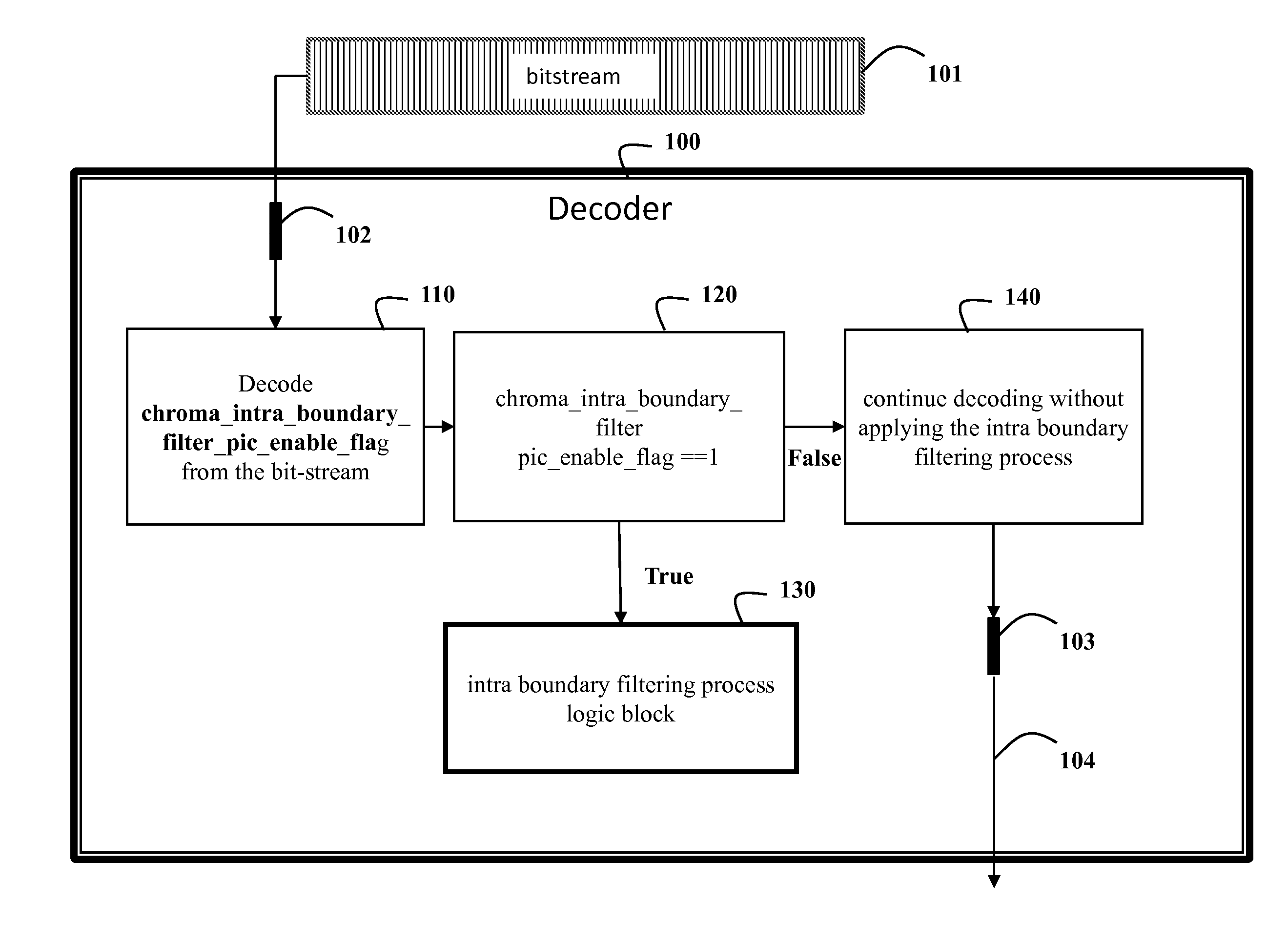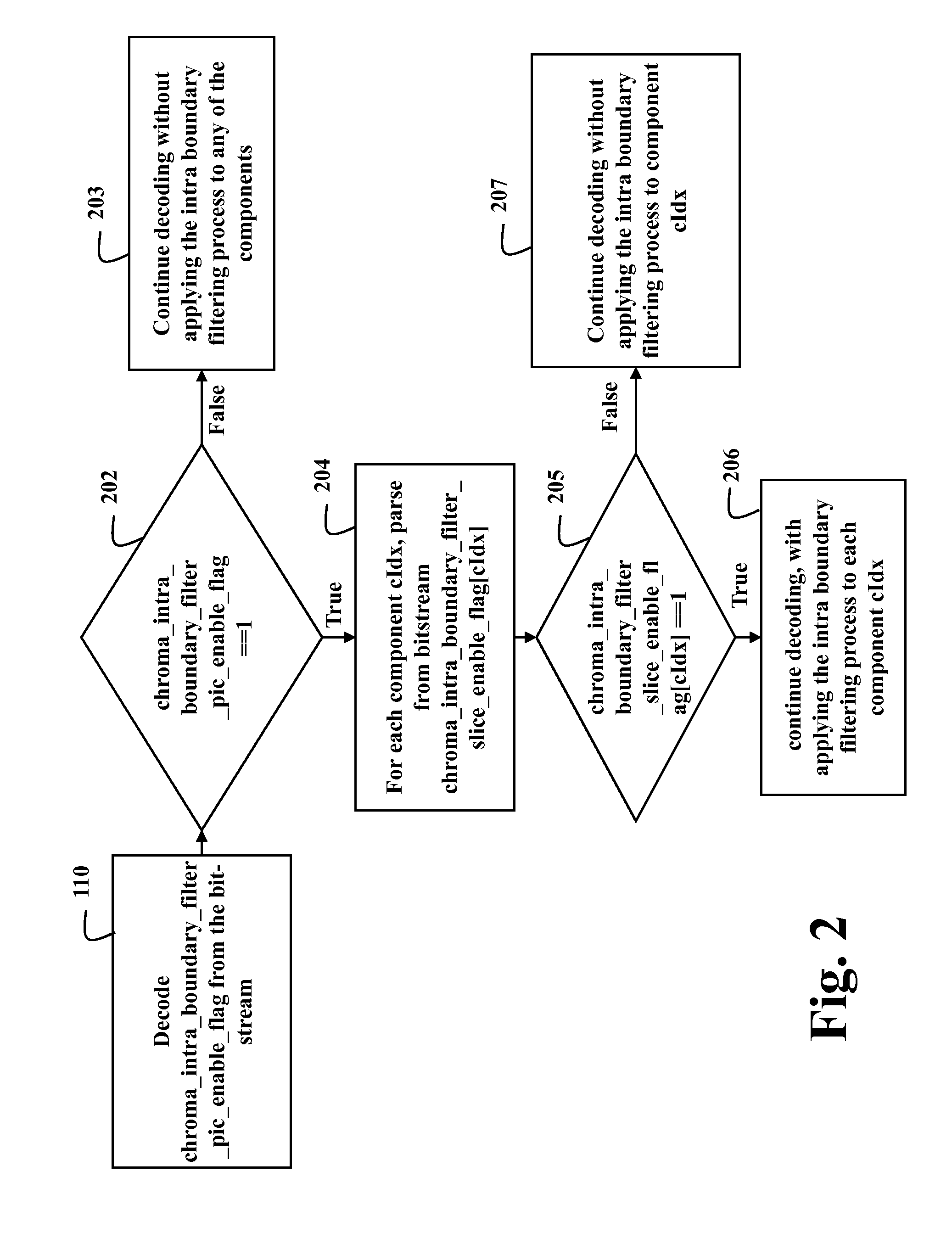Method for Processing Multi-Component Video and Images
a multi-component video and image technology, applied in the field of coding pictures and videos, can solve the problems of reducing the coding gains obtained from the cross-component prediction process, and achieve the effect of reducing the coding gains and improving the compression efficiency of the coding system
- Summary
- Abstract
- Description
- Claims
- Application Information
AI Technical Summary
Benefits of technology
Problems solved by technology
Method used
Image
Examples
embodiment 1
[0024]In this embodiment, a high-level flag is used to indicate the presence of a low-level flag, and the low-level flag indicates whether intra boundary filtering is applied to a component in a picture in a bitstream.
[0025]Table 1 shows definitions of the flags used by embodiments of the invention.
TABLE 1Descriptorseq_parameter_set_rbsp( ) {...cross_component_prediction_enabled_flagu(1)chroma_qp_adjustment_enabled_flagu(1)chroma_intra_boundary_filter_pic_enable_flagu(1)slice_segment_header( ) ( ) {...if( chroma_qp_adjustment_enabled_flag )slice_chroma_qp_adjustment_enabled_flagu(1)If(chroma_intra_boundary_filter_pic_enable_flag)chroma_intra_boundary_filter_slice_enable_flagu(1)...
[0026]Of particular interest are the following flags:
[0027]chroma_intra_boundary_filter_pic_enable_flag==1 specifies the chroma_intra_boundary_filter_slice_enable_flag is present in a slice segment header syntax, and chroma_intra_boundary_filter_pic_enable_flag==0 specifies the chroma_intra_boundary_filter...
embodiment 2
[0035]This embodiment modifies embodiment 1 by using the low-level flag to also enable or disable the application of an offset process to a component. The process for when to apply the offset process is shown in FIG. 3.
[0036]If intra boundary filtering is enabled for the first component, then a chroma_intra_boundary_filter_pic_enable_flag flag is parsed 310 from the bitstream. The value of this flag is checked 320, and if it is false, then intra boundary filtering is not applied to subsequent (chroma) components, so decoding continues 330 by applying the offset process to the subsequent components during cross-component prediction.
[0037]If chroma_intra_boundary_filter_pic_enable_flag is true, then a chroma_intra_boundary_filter_slice_enable_flag flag is parsed 340 from the bitstream.
[0038]The value of this flag is checked 350, and if chroma_intra_boundary_filter_slice_enable_flag is false, then decoding 330 continues by applying the offset process to the subsequent components during...
embodiment 3
[0043]This embodiment is a modification of Embodiment 1, in that the high-level flag and the low-level flag can be used to enable or disable the boundary filtering process for the first component, e.g., luminance, as well as the remaining components, e.g. chrominance. Examples of implementations of this process are to modify the related syntax from the earlier embodiment to remove the dependence on the component index cIdx, so that if ChromalntraBoundaryFilterEnable is equal to 1, then the intra boundary filtering is applied to the component. This modification has the effect of making chroma_intra_boundary_filter_pic_enable_flag and chroma_intra_boundary_filter_slice_enable_flag enable intra boundary filtering for all components.
PUM
 Login to View More
Login to View More Abstract
Description
Claims
Application Information
 Login to View More
Login to View More - R&D
- Intellectual Property
- Life Sciences
- Materials
- Tech Scout
- Unparalleled Data Quality
- Higher Quality Content
- 60% Fewer Hallucinations
Browse by: Latest US Patents, China's latest patents, Technical Efficacy Thesaurus, Application Domain, Technology Topic, Popular Technical Reports.
© 2025 PatSnap. All rights reserved.Legal|Privacy policy|Modern Slavery Act Transparency Statement|Sitemap|About US| Contact US: help@patsnap.com



